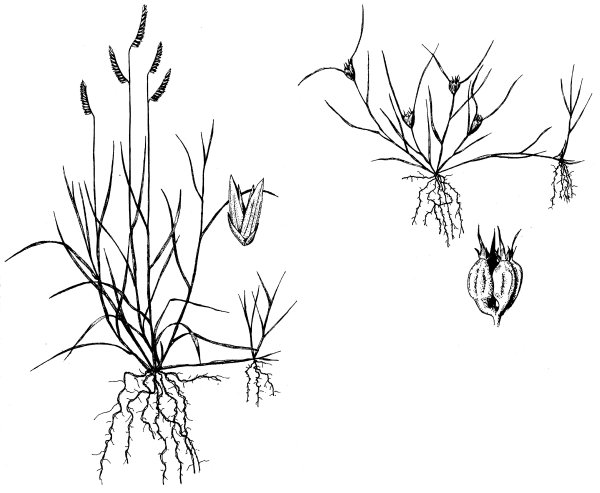
Buchloe dactyloides (Nutt.) Engelm. Buffalograss Habit: Creeping dioecious stoloniferous perennial, forming a dense sod, the curly blades forming a layer commonly 5-10 cm. thick. Culms: Commonly 10-20 cm. long, those of the pistillate plants usually shorter, in small tufts, or in densely matted small or large patches, or forming a continuous sod, slender, erect or decumbent at the base, with stolons 5-60 cm. long, the nodes glabrous, often with a tuft of small leaves, frequently rooting at the nodes, forming new plants. In the staminate plants, the culms exceed the leaves, while in the pistillate plants the leaves exceed the culms. Blades: 2-10 cm. long more or less, 1-2 mm. wide, sparingly pilose or ciliate on both the upper and lower surfaces. Sheaths: Loose, mostly pilose in the throat; those of the pistillate plant partly enclosing the pistillate inflorescence. Ligule: A ring of hairs. Inflorescence: In the staminate plant 2-3 nearly or quite sessile, approximate, one-sided spikes 5-15 mm. long on a slender culm, 5-20 cm. tall, each spike of about 10 spikelets, each spikelet about 4 mm. long; in the pistillate plant 1-2 spikes in a head, 3-4 mm. thick, somewhat in leaf sheaths and the parts indurated. Staminate spikelets: 2-flowered, sessile and closely imbricate, in two rows on one side of a slender rachis, forming a short spike; glumes somewhat unequal, rather broad, 1-nerved, acutish, lemma longer than the glumes, 3-nerved, rather obtuse, whitish, palea as long as its lemma. Pistillate spikelets: Usually 4-5 in a short spike or head, this falling entire, usually 2 heads to the inflorescence, the common peduncle short and included in the somewhat inflated sheaths of the upper leaves, the thickened indurate rachis and broad outer (second) glumes forming a rigid, white, obliquely globular structure crowned by the green-toothed summits of the glumes; first glume (inside) narrow, thin mucronate, well-developed to obsolete in the same head, second glume firm, thick and rigid, rounded on the back, obscurely nerved, expanded in the middle, with inflexed margins, enveloping the floret, abruptly contacted above, the summit with 3 green rigid acuminate lobes; lemma firm-membranous, 3-nerved, dorsally compressed, broad below, narrowed in a 3-lobed green summit, the middle lobe much the larger; palea broad, obtuse, about as long as the body of the lemma, enveloping the caryopsis. Habitat: Dry plains. May-July. Kansas Range: Throughout, but most abundant westward. Remarks: Typically found on finer-textured soils where the area has been heavily grazed.